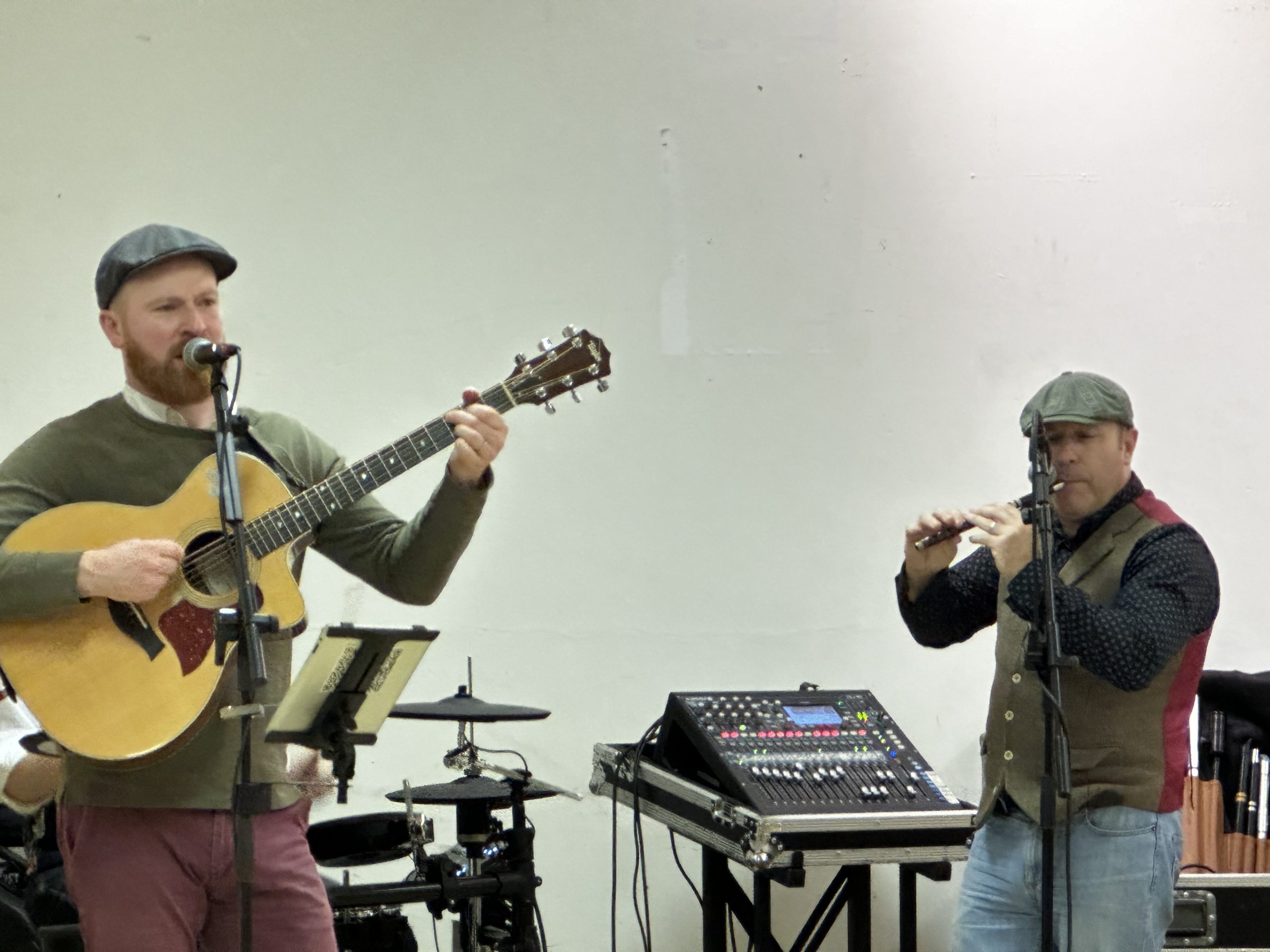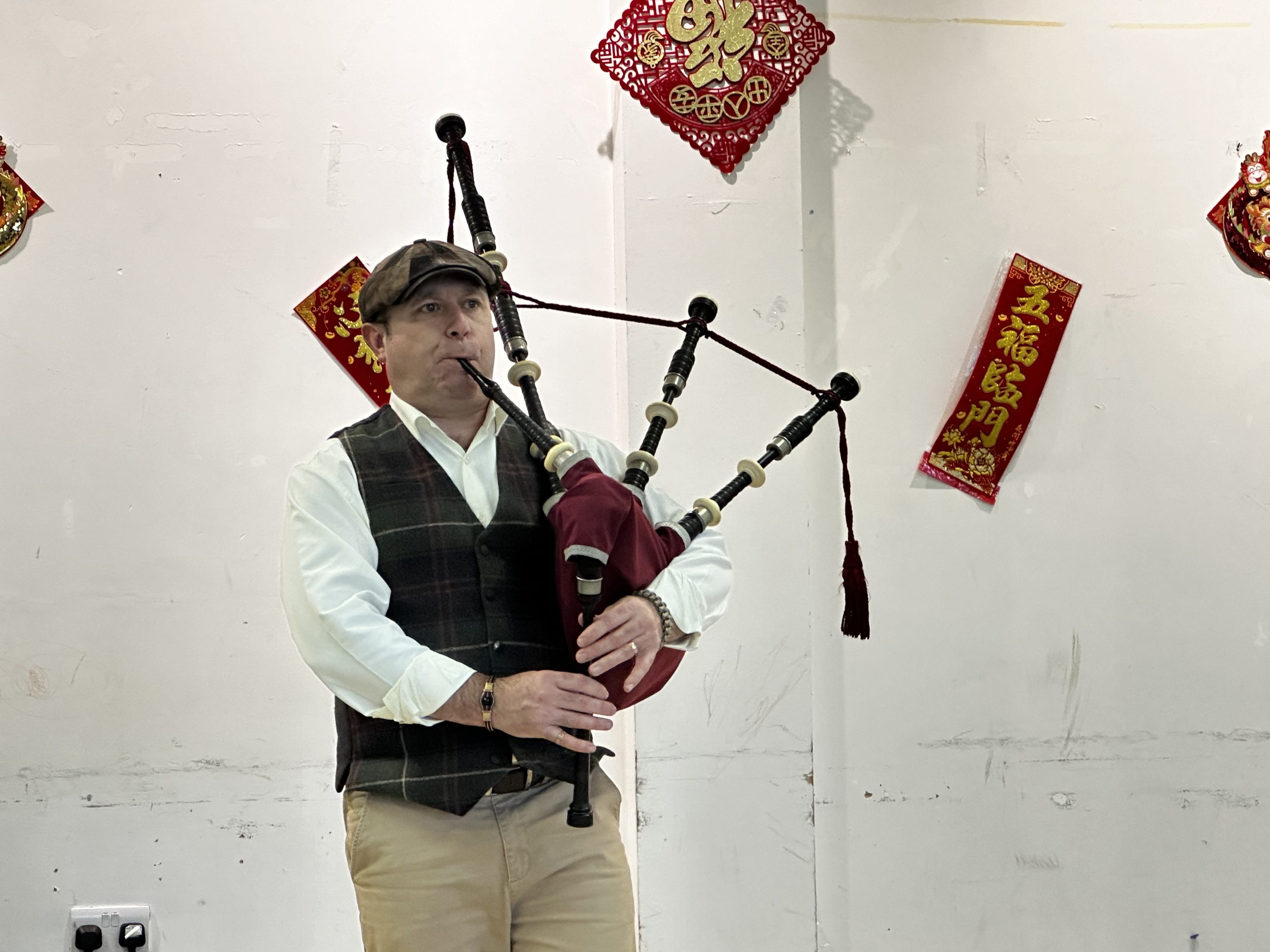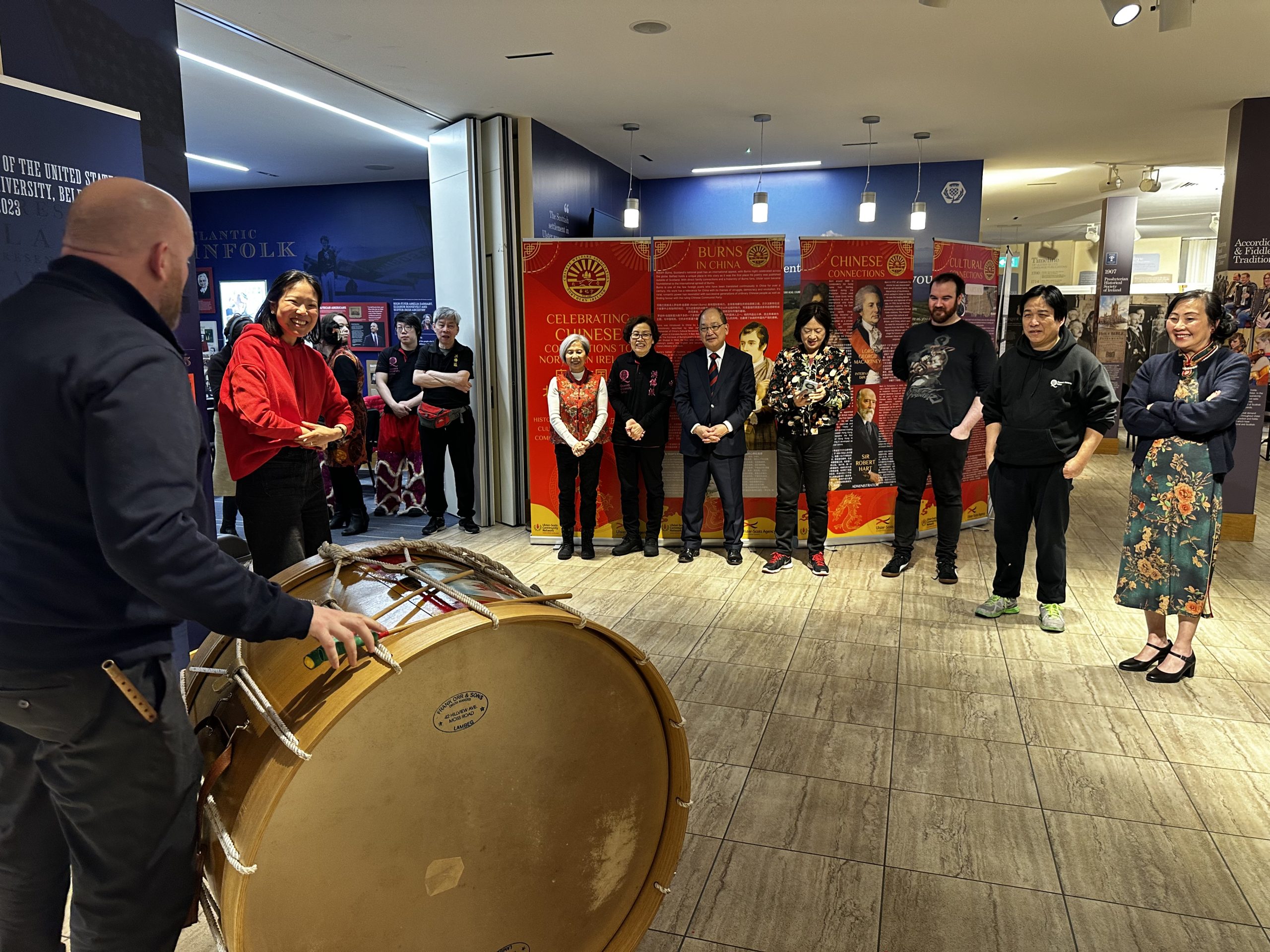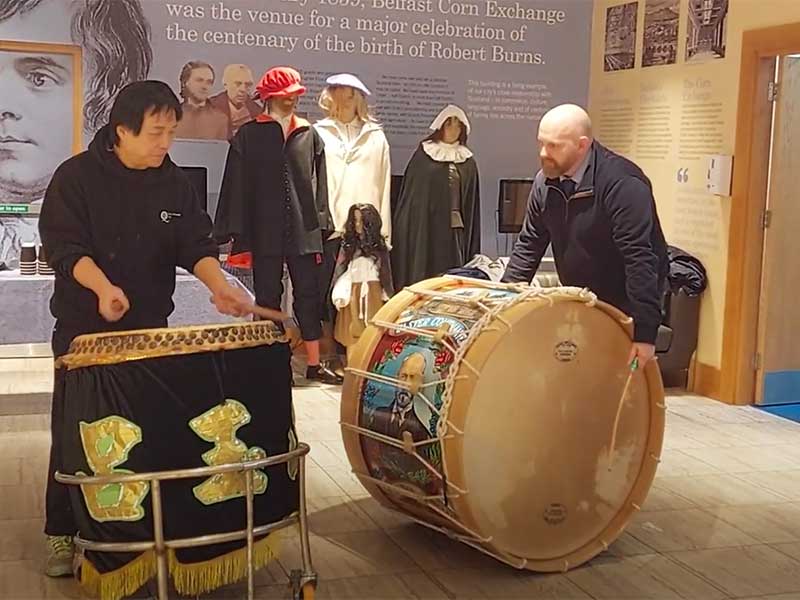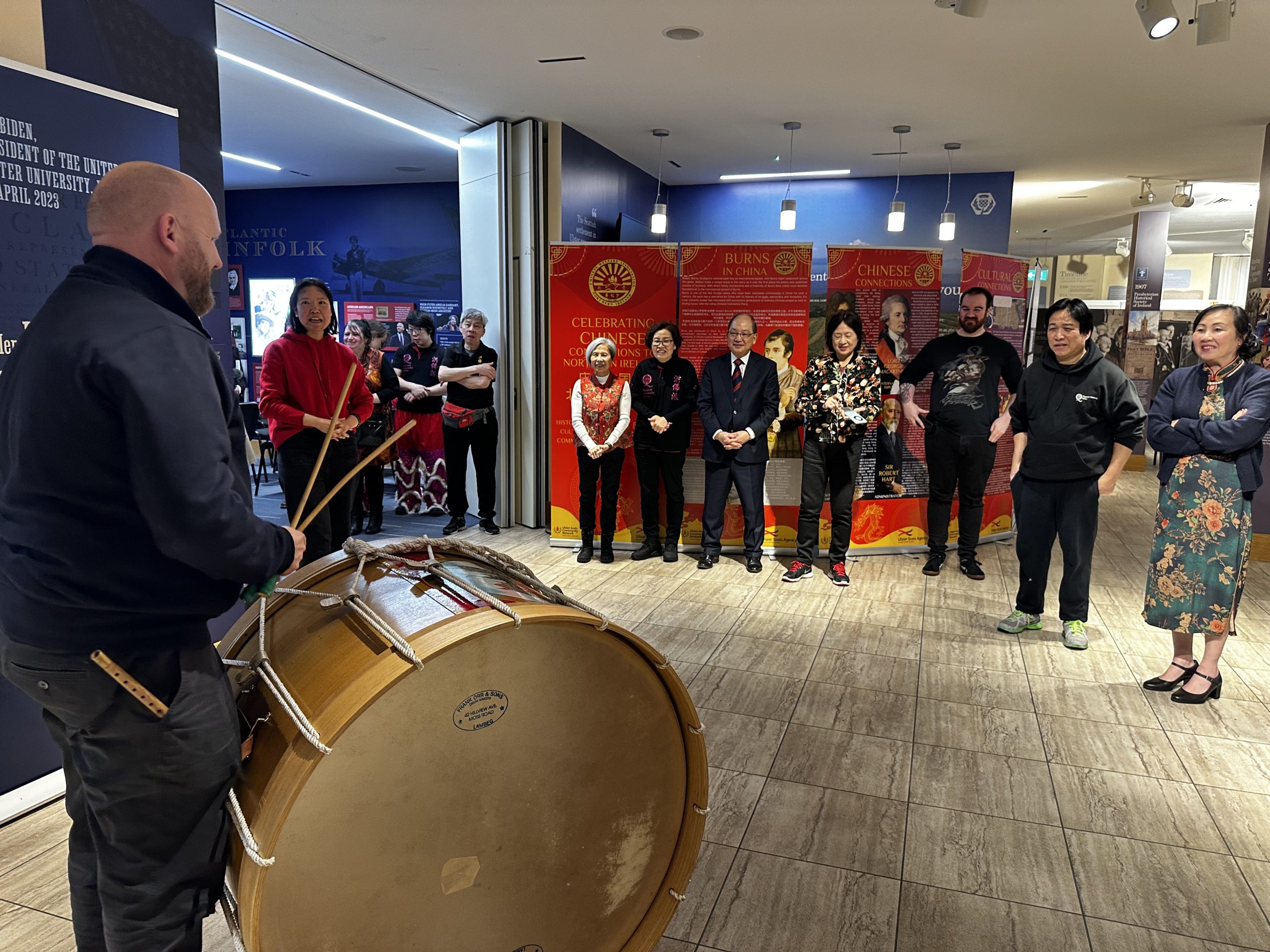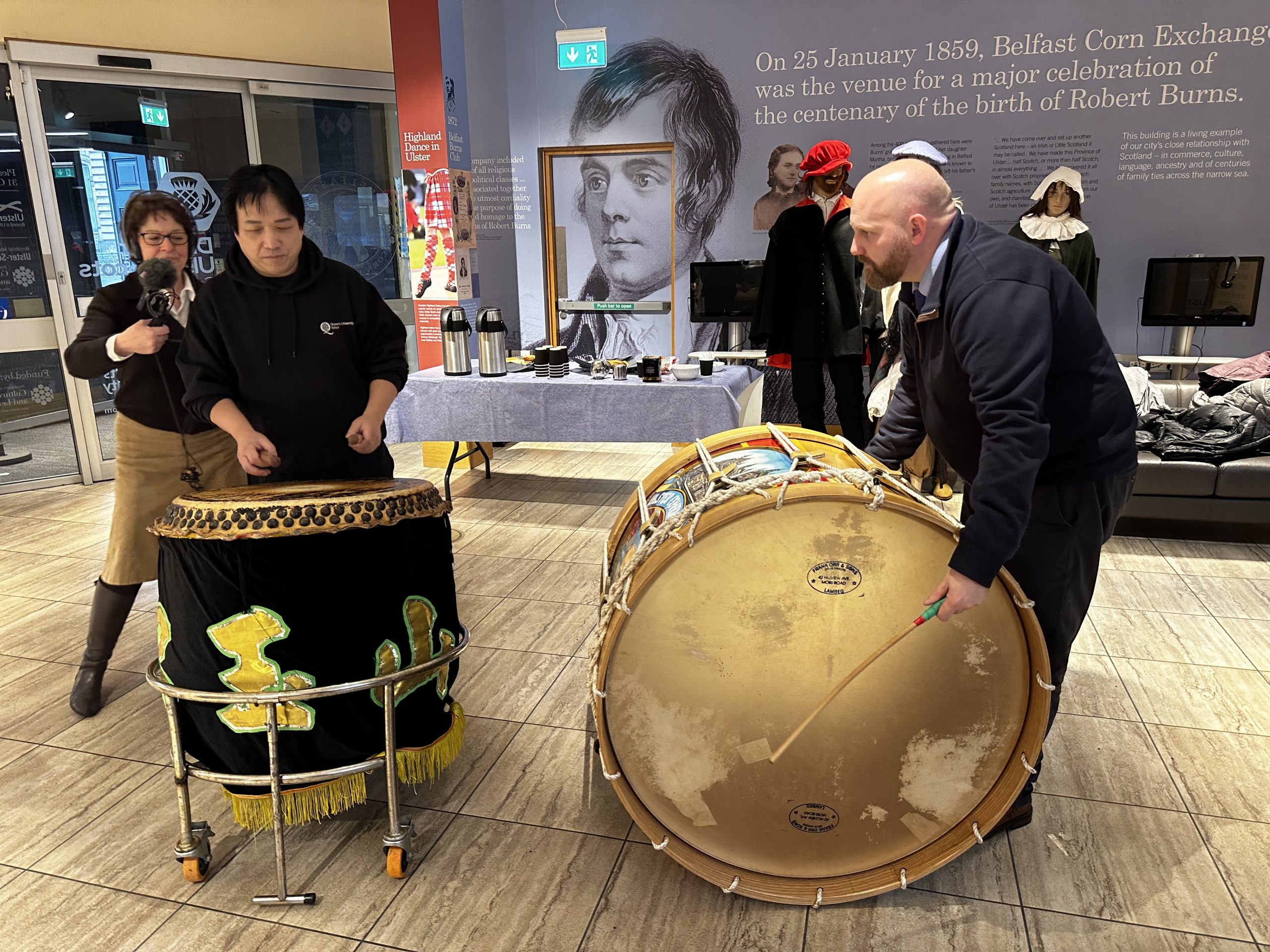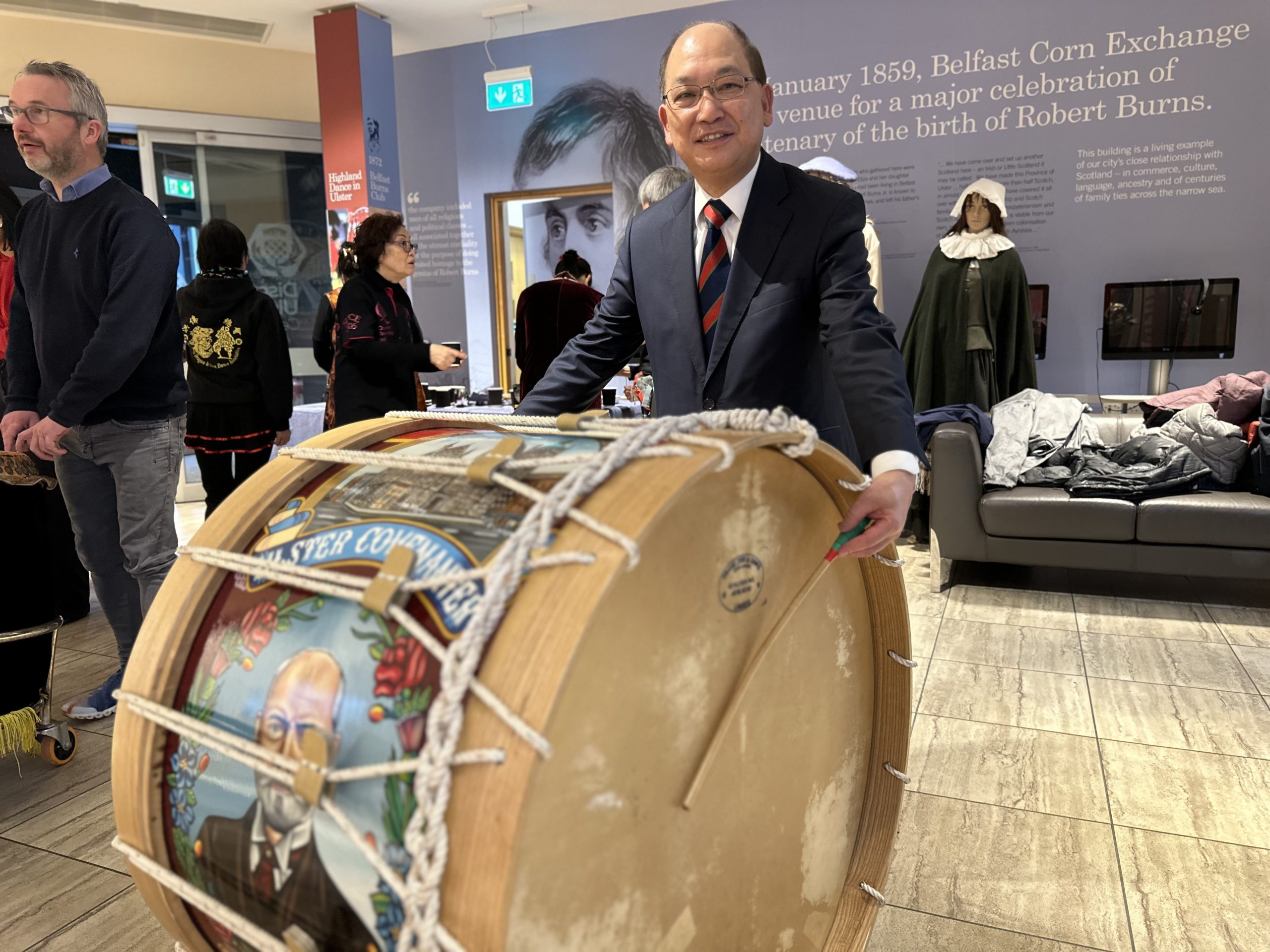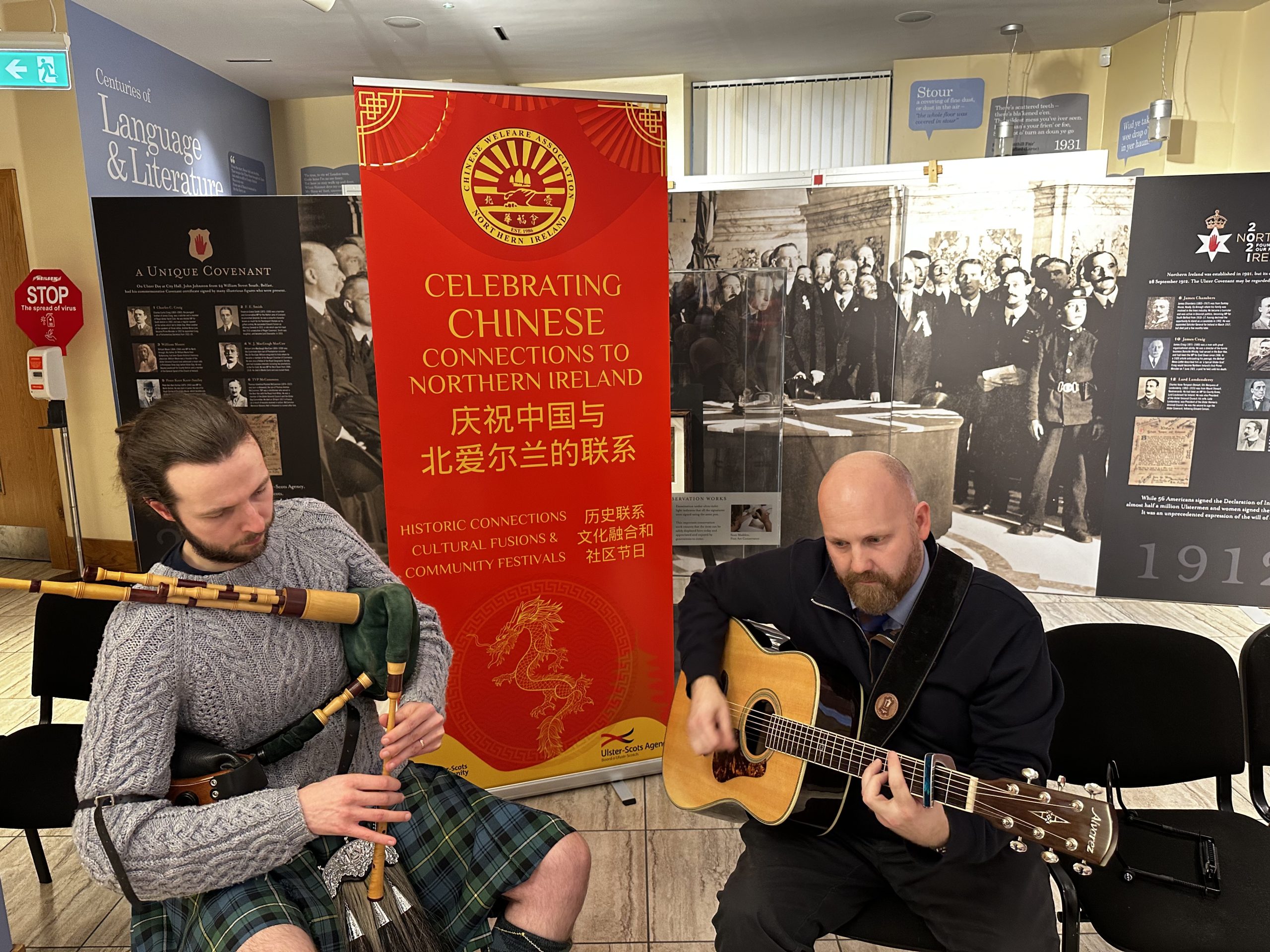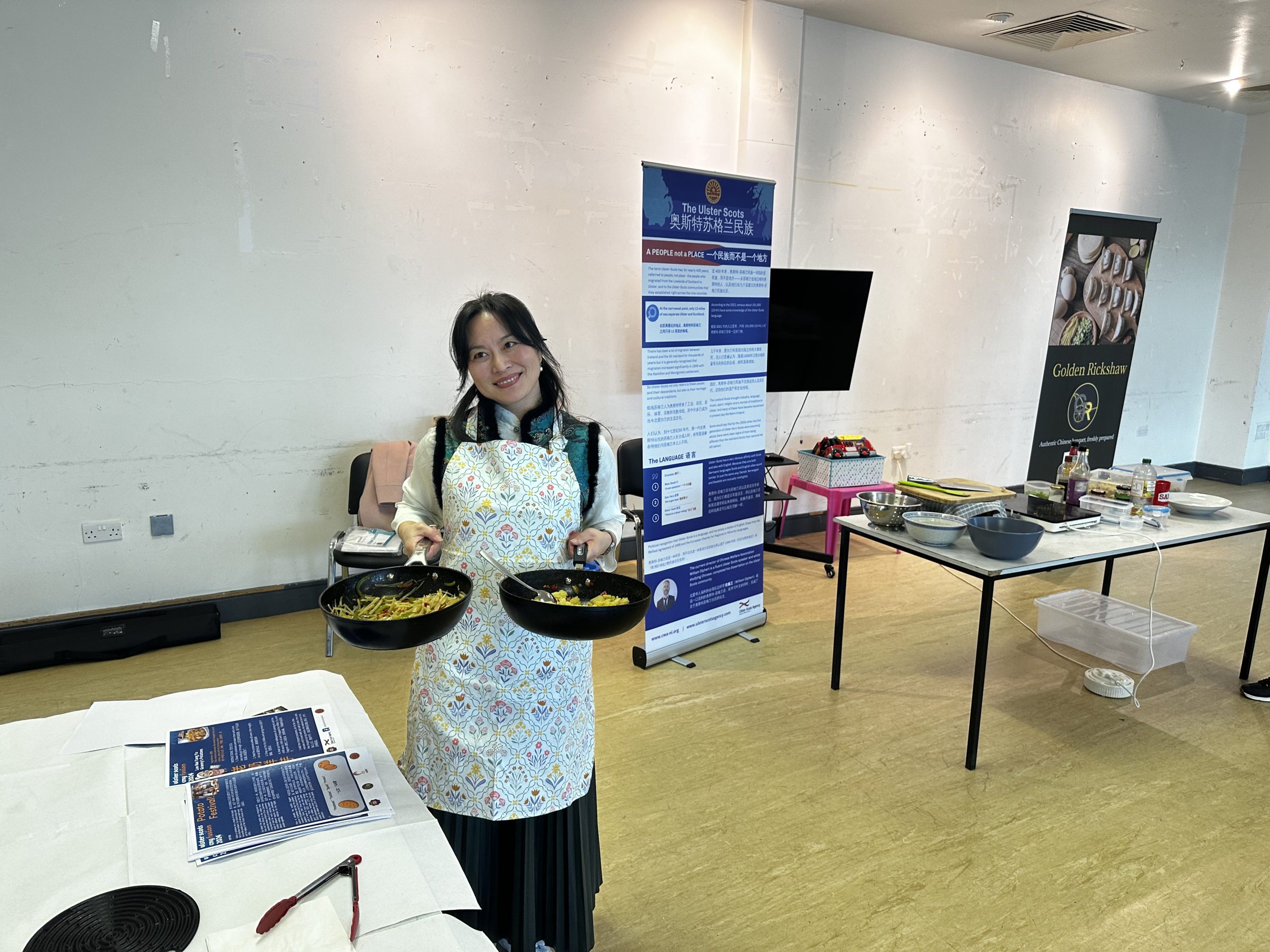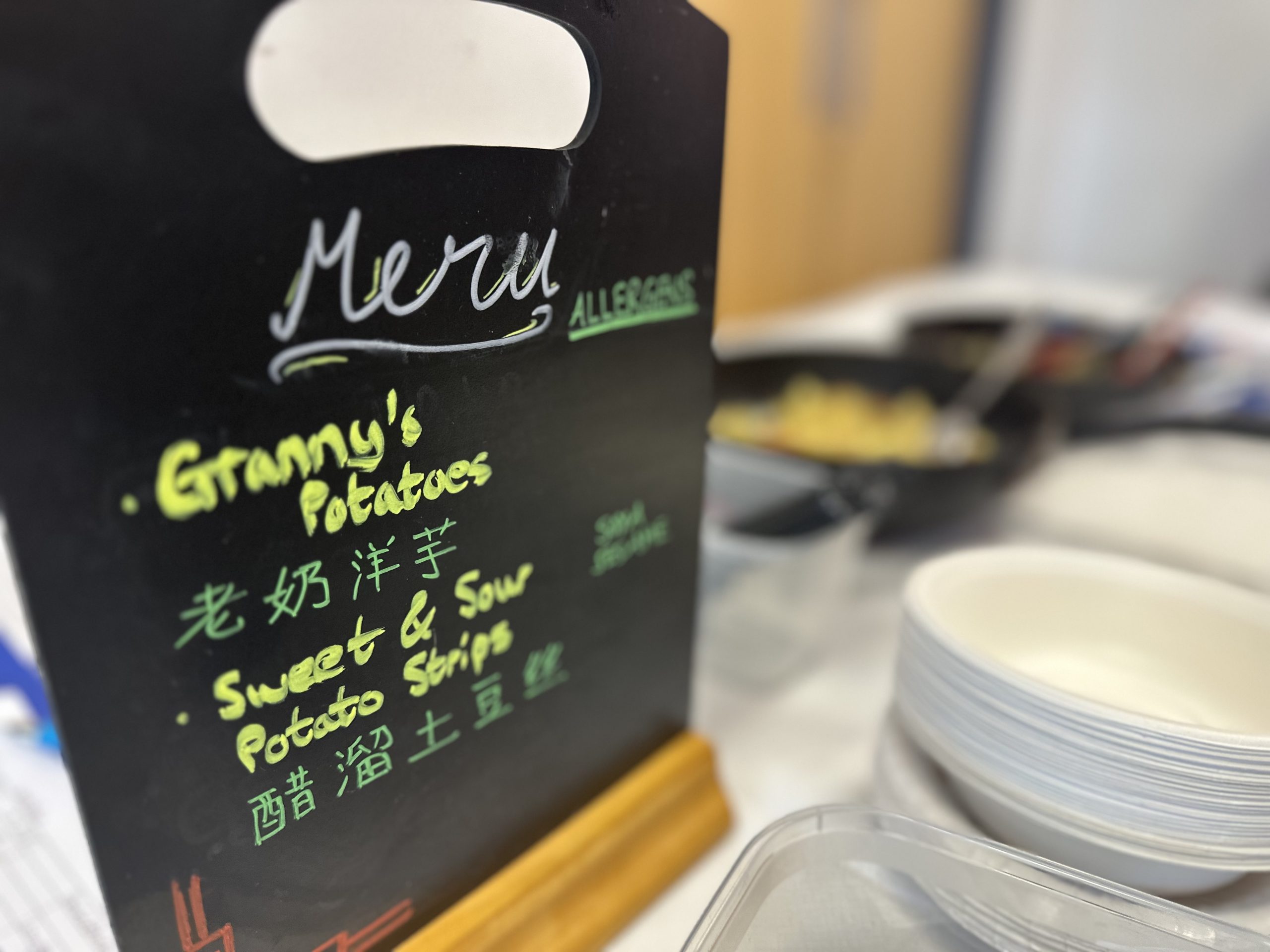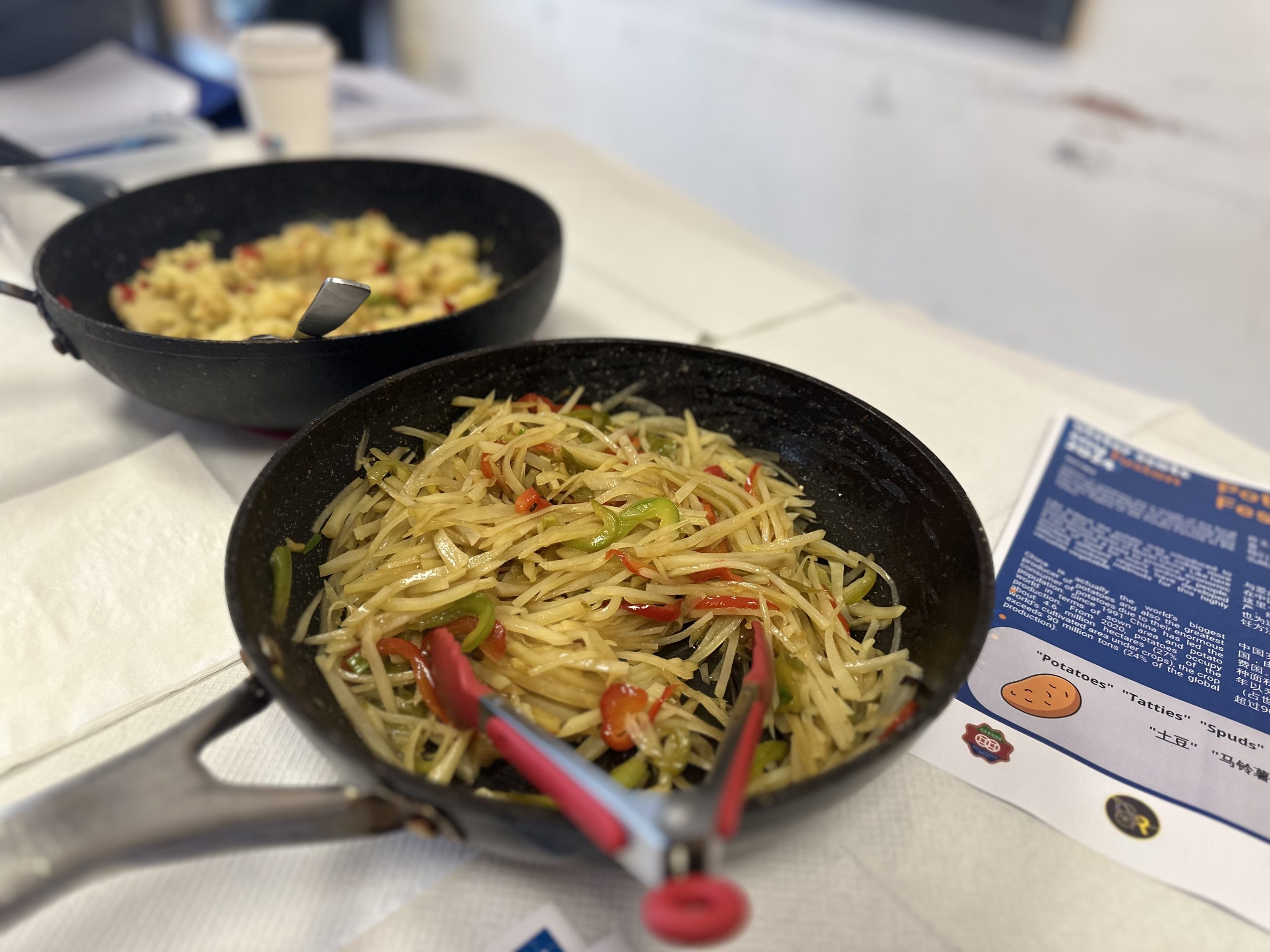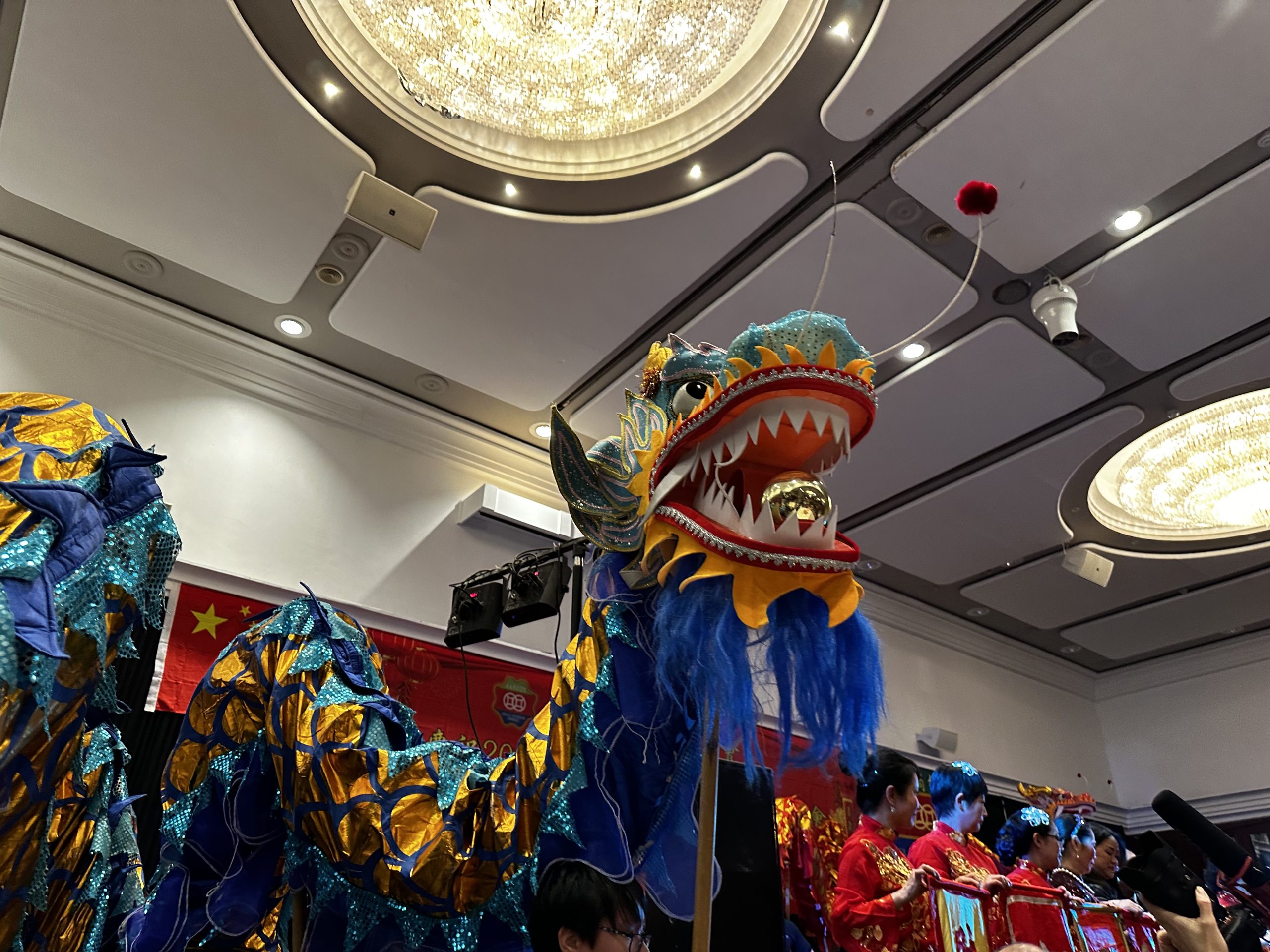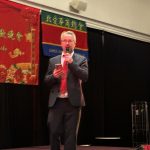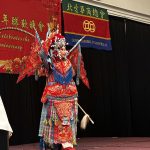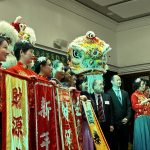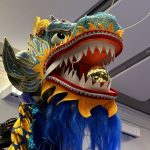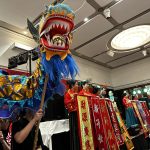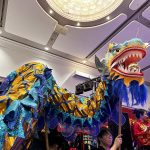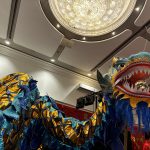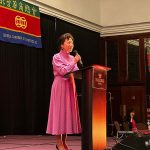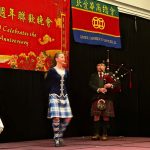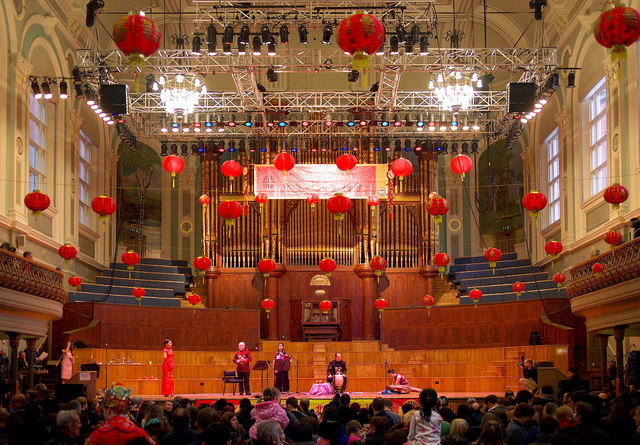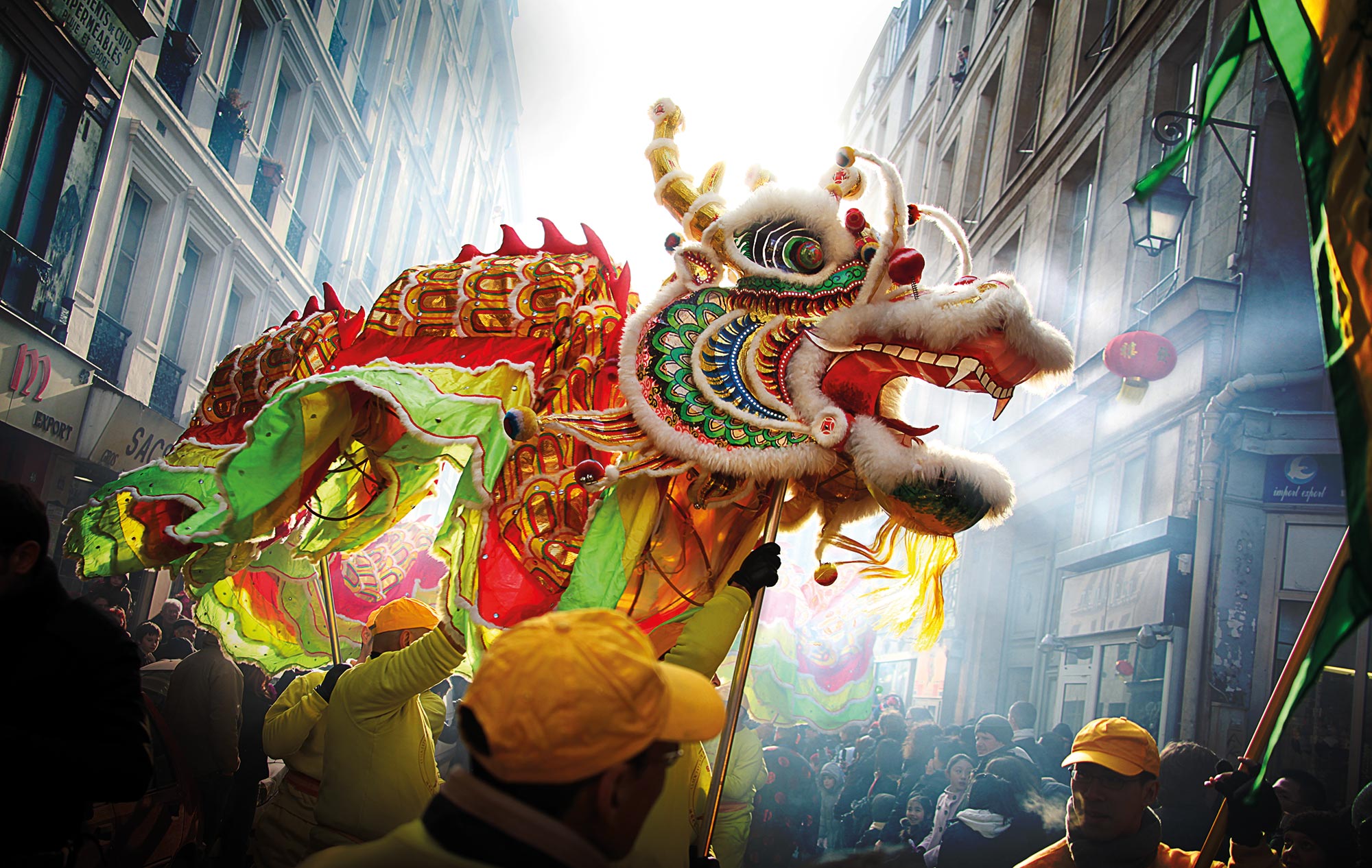Now You're Talking
In our attempts to explore the language as a link, our own William Olphert who is a native Ulster Scots speaker enjoyed an afternoons crack with Anne Blair.
华福会的董事总经理 William Olphert 能说一口流利的阿尔斯特苏格兰语,在与 Anne Blair 的聊天中,他分享了他自己离开北爱尔兰前往中国学习的故事
They explored the links language can create and how it is important to all communities here. William shared his own journey from first experiencing Chinese in school and how that led him to study then visit China.
Ann who is a life long advocate for her native Ulster Scots and hails from the same town where William went to school.
Introduction
Why Chinese?
Closing remarks
Chinese Ceilidh
The Chinese Ceilidh Cultural Fusion Event, held in conjunction with Chinese New Year celebrations, brought together the lively spirit of both Chinese and Scottish cultures in a unique and unforgettable evening of music, and dance. Hosted at the Chinese resource Centre, the event attracted a diverse audience eager to experience the fusion of traditional Ceilidh dances with elements of Chinese culture, creating an atmosphere of excitement and cultural exchange.
A highlight of the event was the Ceilidh dances infused with Chinese flair, where attendees had the opportunity to learn and participate in traditional Scottish dances with a unique twist. Expert instructors guided participants through lively reels, jigs, and strathspeys, incorporating elements of Chinese dance and music to create a dynamic fusion of styles that captivated participants of all ages and backgrounds.
Throughout the evening, live music from Pure Blarney set the pace for the night. From bagpipes and fiddles to tin whistles and flutes a rich blend of Scottish, Irish and Ulster Scots music made it hard to sit still.
In addition to the vibrant music and dance performances, the event featured traditional Irish Stew. From food to music Fusion Event served as a platform for cultural exchange and unity, bringing together individuals from diverse backgrounds to celebrate the traditional ‘hullie’ or ‘ceilidh’. This traditional Scottish and Irish event often help in the winter months was traditionally a great excuse to visit neighbours and come together for a party to dispel the winter blues.
Dances are called, or instructed so that couples have set moves and positions. Half the fun was trying ….. and often failing to learn these set piece dances!
Cultural Connections Exhibition
We have worked with the Ulster Scots Agency to explore the connections between Ulster and China. Our journey of discovery took us back centuries and showed just how important and positive the impact that people from here made in China. An exhibition was designed to fit with the existing permanent display in the Discover Ulster Scots Centre.
The exhibition was designed to provide a tantalising taste of the historical and cultural links between China and Northern Ireland, spanning from the diplomatic missions of Lord McCartney to the influential legacy of Sir Robert Hart. Hosted at both the Chinese Resource Centre and Discover Ulster Scots Centres, the exhibition offered visitors a comprehensive overview of the enduring connections and shared experiences that have shaped the relationship between these two rcountries over the centuries.
Lord McCartney's Diplomatic Mission:
The exhibition commenced with a focus on the groundbreaking diplomatic mission of Lord McCartney in 1793, which marked one of the earliest official interactions between Britain and China. Through the display panels visitors gained insight into McCartney's historic journey to the Qing Empire, highlighting the early beginnings of cultural exchange and trade relations between China and the United Kingdom.
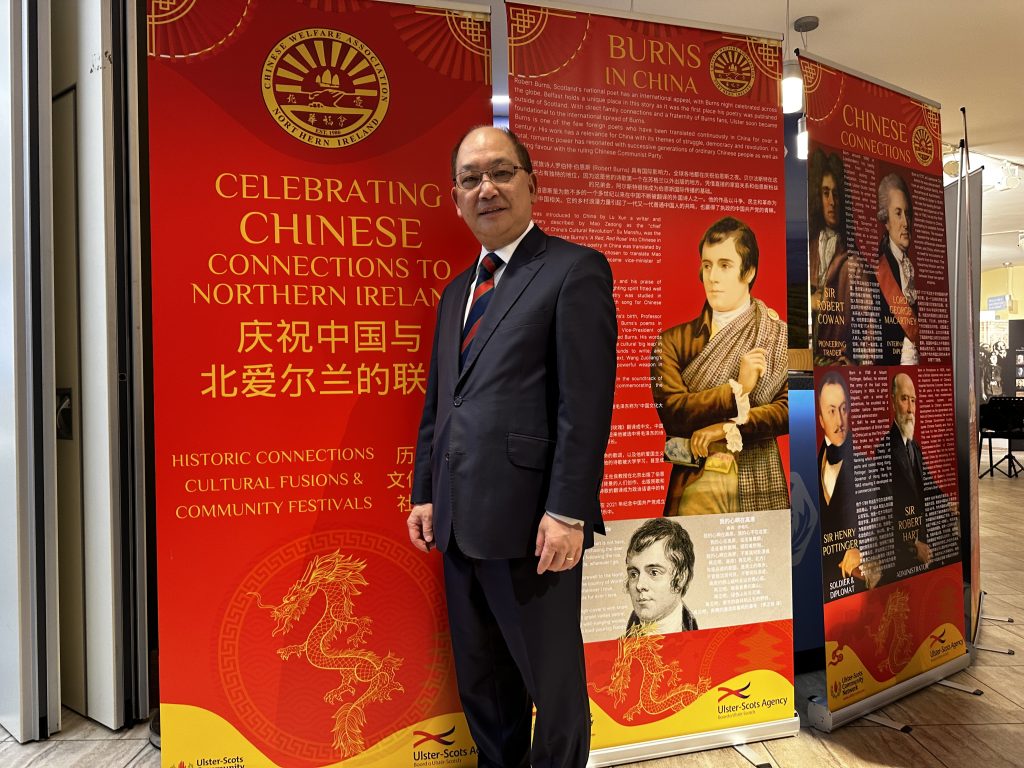
Industrial Revolution and Trade Ties:
Moving forward in time, the exhibition explored the pivotal role of Northern Ireland in maritime de elopements and trade routes of the 18th and 19th centuries. Visitors learned about the impact of economic links and early trade pioneers like Sir Robert Cowan.
Legacy of Sir Robert Hart:
A central focus of the exhibition was the legacy of Sir Robert Hart, a native of Northern Ireland who played a pivotal role in shaping China's modernisation efforts during the late Qing dynasty. Visitors discovered Hart's remarkable contributions as the Inspector General of China's Imperial Maritime Customs Service, highlighting his deep love for and positive role in China
Cultural Exchange and Mutual Understanding:
Throughout the exhibition, emphasis was placed on the cultural exchange and mutual understanding that have flourished between China and Northern Ireland over the centuries. From Chinese students studying in Northern Irish universities today to cultural events and artistic collaborations, we hope the exhibition will prompt visitors to discover a deeper appreciation for the rich tapestry of connections that continue to thrive between these distant yet interconnected regions.
Our Cultural Connections Exhibition also explored how we are linked by foot, fashion and folk traditions. Through the stories of visionary diplomats like Lord McCartney and trailblazing individuals like Sir Henry Pottinger the founding father of Hong Kong, visitors will appreciate a more nuanced understanding of the enduring legacy of collaboration and exchange that continues to shape the relationship between Ulster and China.
It is a first step which we hope will whet the appetite of both communities to explore more. We believe the exhibition renewed appreciation for the interconnectedness of our world and the importance of fostering mutual respect and understanding across cultures.
Clash of Drums
In perhaps the most noisy cultural exchange ever seen in Belfast drummers from the Lion dance and Lambeg traditions met for a ‘drum in’. This cultural fusion was a first and gave expert drummers from these different traditions an opportunity to learn from one another and play together. The Lambeg drum know locally as the ‘Big Drum’ was matched by the Chinese Drum as they went ‘head to head’.
Both Chinese and Lambeg drums are iconic and influential in the musical traditions and folklore of their own communities. Both drums find their origins in military music, and their role on the battlefield to communicate messages and motivate troops. They then both grew in size and volume becoming unique cultural icons with accompanying music and even dance formed to complement their percussive presence.
Each drum had given birth to a proud heritage often passed from generation to generation as time is take to ‘master’ these giant instruments. Those who play them have a certain privileged position above other musicians and often begin their lifelong passion at a young age.
In each case the beat happened out is the lead for other artists. In the case of the drums used in the Lion and Dragon dances they control the movements of the dancers as they bring these costume creatures to life.
Drums (gu) are a very important part of Chinese culture. A Chinese character representing “drum” was first inscribed on bones and shells about 3000 years ago. The earliest known drums in China date back nearly four thousand years ago, around the time of the Shang Dynasty (c.1600 – c.1100 BCE). The lambeg drum can only traces its history back to the late 1600s AD !
To be very successful in the dance, the head of the Dragon must be able to coordinate with the body movement to match the timing of the drum. The Lion whose head is capable of different movements and expressions is likewise led by the drum beats.
In the Ulster Scots tradition the beat of the lambeg is set to tunes which can be fifed or piped to and often dancers follow the beat for their intricate steps.
Given our shared heritage of drumming on a giant scale one of the most exciting and innovative features of the Chinese New Year Fusion Festival was a ‘Drum Off’. We invited expert drummers to learn from each other and bring together their two traditions. From drumming each others drums they also tried their own beats on these very different drums to see what it would sound like.
The whole exciting experiment was captured for Radio Ulster and was the highlight of the visit.
Cultural Connections
The Chinese community were kindly hosted by the Ulster Scots Community Network in the impressive Discover Ulster Scots Centre. The event brought both communities together to learn about each other and explore each other’s culture and traditions. The event included a tour of the Centre, a talk on the origins and heritage of the Ulster Scots community in Northern Ireland.

After a tour of the Centre and their permanent exhibitions a short presentation on the origins of the Ulster Scots community and their contribution internationally was enjoyed by all. It was interesting to see the parallels between the two communities who had made their home here as it was explained that the Ulster Scots were often seen as as an immigrant community here.
The pipes and drums marked the end of the presentation as different musical instruments, traditions and dress were showcased by the staff. Our thanks to Matthew Warwick of the Ulster Scots Community Network who was not only knowledgable about the history but a great educator as well as talented musician.
One of the highlights of the trip was listening to our own Rebecca Ng translate the English presentations and exhibitions which were often laced with Ulster Scots words and phrases. She certainly worked hard that day but enjoyed herself.
In welcoming us to the centre David Gilland explained the work they are involved in and his welcome was responded to by William Olphert who shared his own language journey. Growing up as a native Ulster Scots speaker from the North Antrim coast, he developed a passion for language which led to studying Chinese and eventually brought him to work for CWA.
In the spirit of our cultural fusion theme the Centre welcomed the Success Dragon and Lion Dance Troupe led by Master Alan Liu. His expert drumming set the tone and pace for a traditional dance display.
Potato Festival
The Food Fusion Potato Festival held at the Chinese Resource Centre was a remarkable celebration of culinary creativity and cultural exchange, highlighting the humble but versatile potato and its diverse culinary uses in both China and Northern Ireland. The festival brought together food enthusiasts, and the culturally curious to explore the fascinating fusion of flavours and techniques that resulted from the intersection of these two distinct cuisines.
Cookery Demonstration:
A central highlight of the festival was the captivating cookery demonstration, where Bonny Cooper of China Connections displayed her expertise in using potatoes in innovative ways. The demonstration provided attendees with valuable insights into the similarities and differences in the culinary traditions of both regions, demonstrating how the humble potato could be transformed into a wide array of mouthwatering dishes including ‘Granny’s Potatoes’ and the totally new way of stir frying potatoes to produce crunchy sweet and sour potato strips.
Bonny demonstrated traditional and modern techniques for incorporating potatoes into Chinese cuisine. The use of the potato in the wetter colder north of china has created an array of dishes from crispy potato pancakes to savory stir-fries and delicate potato dumplings.
The audience was treated to a both of Bonny’s potato creations that showcased the versatility of the humble spud in Chinese cooking.
Both main traditions in Northern Ireland also value the potato as a staple of their diet. Indeed no other food has such a central place in Irish cuisine and culture both north and south. Potatoes have been an integral part of Irish cuisine for centuries, with classic Irish potato dishes such as champ, colcannon, boxty, and potato bread, as well the ever popular chips, French fries, wedges and everyones favourite the roasties.
Cultural Exchange and Collaboration:
The Food Fusion Potato Festival provided a platform for cultural exchange and collaboration between Chinese and Northern Irish chefs, fostering mutual understanding and appreciation for each other’s culinary heritage. Our audience had the opportunity to engage with the chef, learn about different cooking techniques, and gain a deeper appreciation for the cultural significance of the potato in both regions.
It was a resounding success, bringing together the best of Chinese and Northern Irish culinary traditions in a celebration of food, culture, and innovation.
Recipe cards
Click each recipe card to view larger.
Gala Dinner
The Chinese New Year Gala Dinner held at Europa Hotel in Belfast was a resounding success, marking the return of this event in its traditional format. The capacity crowd enjoyed a showcase blend of cultural richness, culinary excellence, and festive atmosphere. The event, was organised to celebrate the arrival of the Year of the Dragon, and attracted an enthusiastic audience eager to immerse themselves in the traditions and festivities of Chinese culture.
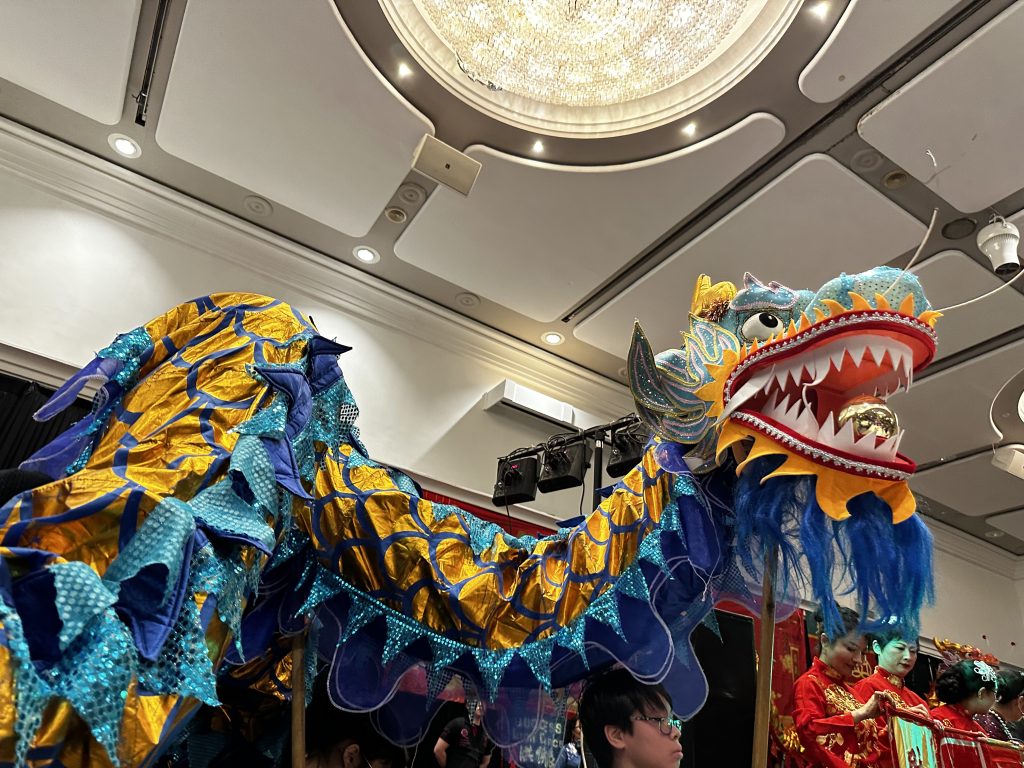
The evening commenced with guests and dignitaries being piped in and enjoying a display of traditional Ulster Scots music and Highland dance. The tope table guests included Consul General Madame Zhang Meifang, the Lord Lieutenant Fionnuala Jay-O’Boyle, Lord Mayor of Belfast, CWA Chairman Danny Wong and Chinese Chamber of Commerce Board Members.
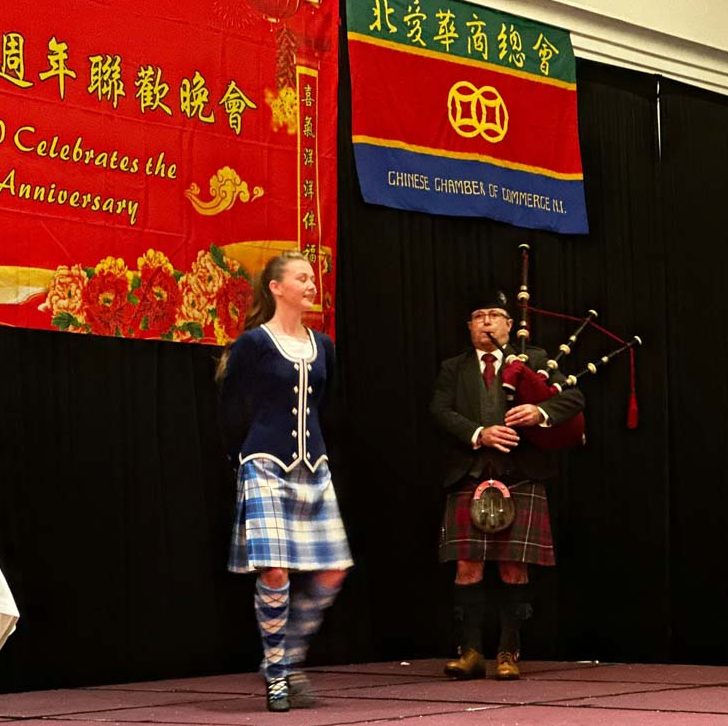
The event which was jointly organised by Chinese Welfare Association and the Chinese Chamber of Commerce was all the more special as it celebrated the 40th anniversary of the establishment of the Chinese Chamber of Commerce N.I. Organisers said
“On this special evening, we gather to celebrate the most significant traditional festival which is full of laughter, reunions, and hopes, symbolising new beginnings and auspicious wishes."
Guests were treated to an array of captivating cultural performances that set the tone for the evening. Acts included mesmerising lion dances, graceful traditional dances, as well as the high energy musical performances that transported them to the heart of China's vibrant heritage. The performances not only entertained but also provided insight into the significance of various customs and rituals associated with the Chinese New Year.
In a programme packed with the very best of Chinese entertainment, the audience was treated to a whirlwind of drums and dance. The Europa Hotel was transformed with vibrant decorations, auspicious traditional symbols, and atmospheric lighting creating an atmosphere of tradition and celebration. From elegant table settings to thematic decor elements, every detail was carefully curated to evoke the spirit of the Chinese New Year and immerse guests in a world of cultural splendour.
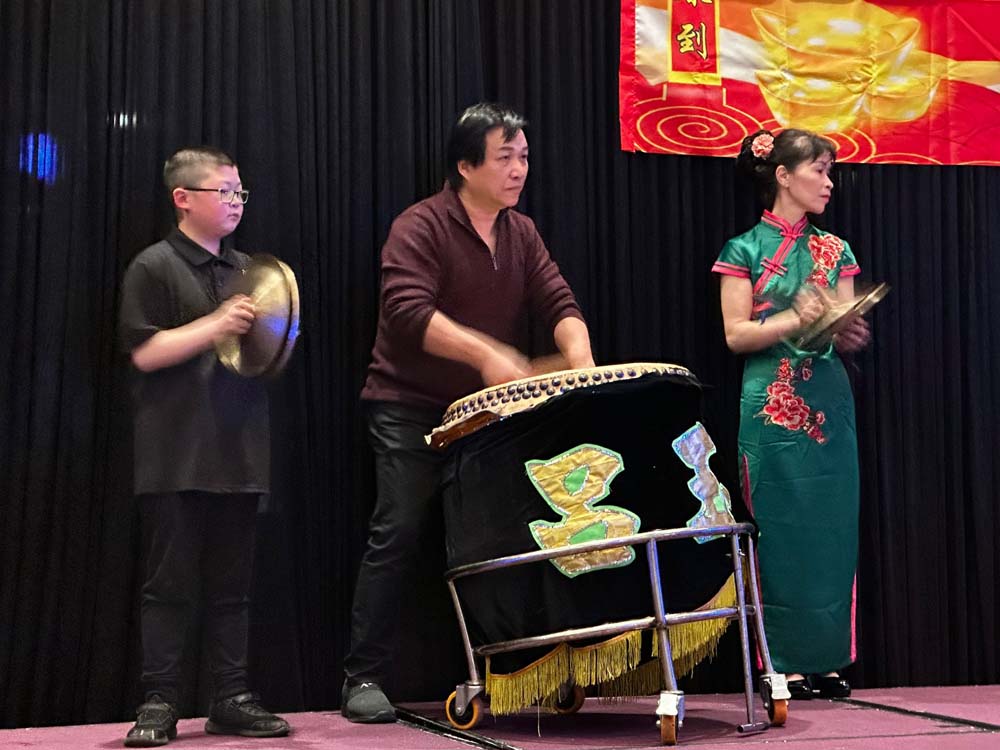 The Gala Dinner served as a platform for fostering community engagement and cultural exchange with the theme of fusion. Attendees from diverse backgrounds came together to celebrate the shared values of unity, prosperity, and happiness. The event provided an opportunity for individuals and organisations from various ethnic minority communities to strengthen ties, forge new connections, and promote mutual understanding. With funding and support from the Ulster Scots Agency the audience was able to watch traditional Ulster Scots music and dance alongside ancient Chinese cultural traditions.
The Gala Dinner served as a platform for fostering community engagement and cultural exchange with the theme of fusion. Attendees from diverse backgrounds came together to celebrate the shared values of unity, prosperity, and happiness. The event provided an opportunity for individuals and organisations from various ethnic minority communities to strengthen ties, forge new connections, and promote mutual understanding. With funding and support from the Ulster Scots Agency the audience was able to watch traditional Ulster Scots music and dance alongside ancient Chinese cultural traditions.
The Chinese New Year Gala Dinner at the Europa Hotel in Belfast was a memorable and enriching experience that brought together the best of Chinese culture and hospitality. From the dazzling performances to the sumptuous food, every aspect of the event was executed with precision and flair, leaving a lasting impression on all who attended. As we look ahead to new beginnings, the Gala Dinner served as a reminder of the power of tradition, community, and the joy of coming together to celebrate life's special moments.
Giant Start to Chines New Year
This year we were delighted to be contacted by the Stena Line Belfast Giants who wanted to celebrate Chinese New Year with us. The home game against the Cardiff Devils on Sunday 4 February 2024, was the perfect opportunity and saw players wear a specially designed kit to celebrate the occasion.
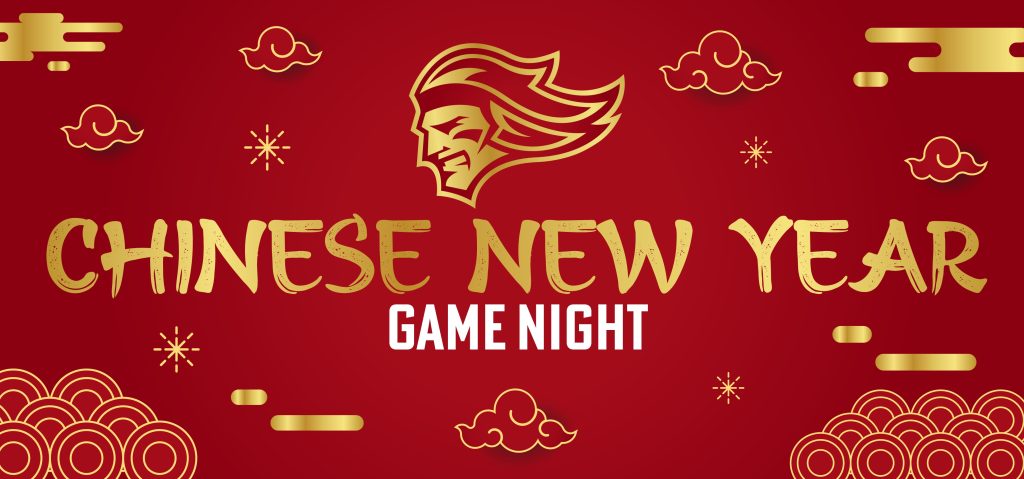
Their website promoted the event and explained to fans the background and significance of the Lunar New Year. The game and the publicity surrounding it was a real bonus to our events raising profile and awareness.

The Giants also explained the nature of the work Chinese Welfare Association is involved in and made the following generous pledge.
“In support of the organisation’s commitment across local communities in Northern Ireland, all profits from the game night Shirt Off The Back raffle on Sunday 4 February 2024 will be donated to the Chinese Welfare Association.”
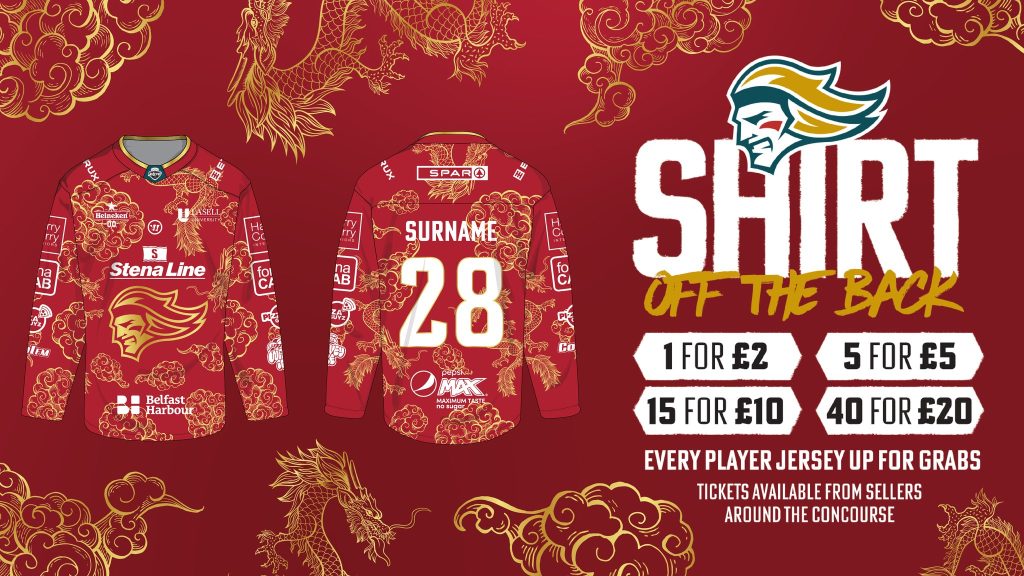
That raffle raised a grand total of £5,384.17 from the themed Shirt Off the Back and a percentage of retail jersey sales. This total will be donated to our work and we will be using it to support young people and our various programmes with them.
We hope that this is the start of something truly ‘giant’ where we introduce our community to ice-hockey which interestingly is very popular in China. The Stena Line Belfast Giants’ community engagement is a valuable part of the work they do in our city and country and we pay tribute to their spirit of inclusivity and leadership.

Chinese Ice Hockey
Interestingly Belfast’s sister city Shenyang is a popular centre for ice-hockey in China. Ice skating has always been popular with Nanhu Park and Beiling Park both having lakes that are cleared for skating, in the winter. Some of Shenyang’s universities have ice rinks as well as four indoor skating rinks in the city. The "Shenyang Ice Eagles" hockey club consists of a mix of foreign and local players.they compete in tournaments with teams from other cities.
Kunlun Red Star is China’s first professional hockey club and was born in 2015. Based in Beijing, it plays in the Kontinental Hockey League (KHL), a professional ice hockey league with teams based in Belarus, Kazakhstan, Latvia, and Russia.

Kunlun Red Star also owns a professional women's ice hockey team, Shenzhen KRS Vanke Rays, based in Shenzhen. Established in 2017, KRS Vanke Rays played in the Canadian Women's Hockey League, with teams based in Canada and the United States.
From 2004 to 2017, several men's ice hockey teams based in China played in Asia League Ice Hockey, a professional league made up of teams from Japan, South Korea, and the Russian Far East.
In 2015, Andong Song became the first Chinese-national drafted by a National Hockey League (NHL) team, a men's professional league consisting of teams from Canada, and the United States. Song was drafted by the New York Islanders in the 6th round (172nd overall) in the 2015 NHL Entry Draft.
In 2019, Rudi Ying became the first Chinese-native to score a goal in the KHL. An impending domestic league has been proposed by the Chinese Ice Hockey Association. The league is assumed to consist of eight clubs; four being the Kunlun Red Star, Jilin City Investment, Beijing Shougang and Zhongshang Hokay.
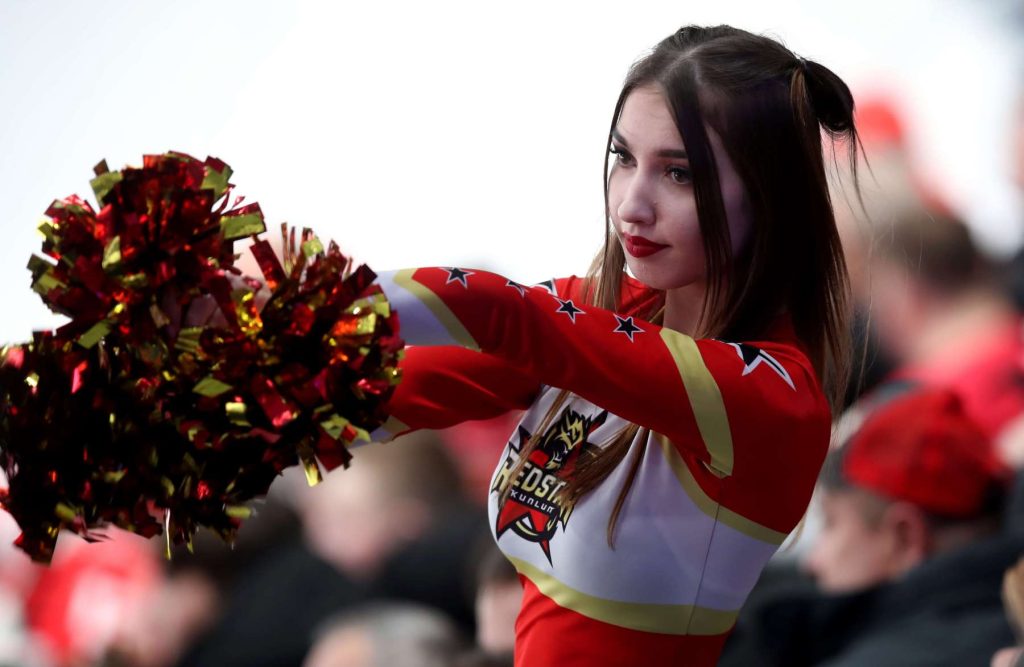
Just like the Belfast Giants Chinese teams are home to some great international talent who live and play their hockey in their country. They have stimulated interest locally in China and with the XXIV Winter Olympic Games hosted there China was proudly represented in the ultimate hockey tournament by both men’s and women’s teams.
The Women’s team achieved two victories – over Denmark and Japan, which was impressive since the Japanese team was significantly higher than the Chinese in the world rankings.
China is looking to expand the sport of hockey and attract teams from around the world to participate in tournaments like the “The Revitalization Cup”. Who knows where the sister city links could take the Belfast Giants next!
Lantern Festival Lights up 2022
On the 15th day of the first lunar month, two weeks after Chinese New Year, another important traditional Chinese festival, the Chinese Lantern Festival or Yuan Xiao Jie or Yuanxiao Festival (元宵节), is celebrated. It marks the first full moon of the new lunar year and the end of the Chinese New Year (Spring Festival) period. Chinese Lantern Festival 2022 will be celebrated on Tuesday, February 15th in 2022.
On the night of the Chinese Lantern Festival, streets are decorated with colorful lanterns, often with riddles written on them. People eat sweet rice balls called tangyuan, watch dragon and lion dances, and set off fireworks.
Content Preview
Chinese Lantern Festival Facts
- Popular Chinese name: 元宵节 Yuánxiāojié /ywen-sshyaoww jyeah/ 'first night festival'
- Alternative Chinese name: 上元节 Shàngyuánjié /shung-ywen-jyeah/ 'first first festival'
- Date: Lunar calendar month 1 day 15 (February 15, 2022)
- Importance: marks the end of the Chinese New Year (Spring Festival) period
- Celebrations: enjoying lanterns, lantern riddles, eating tangyuan a.k.a. yuanxiao (ball dumplings in soup), lion dances, dragon dances, etc.
- History: about 2,000 years
- Greeting: Happy Lantern Festival! 元宵节快乐!Yuánxiāojié kuàilè! /ywen-sshyaoww-jyeah kwhy-luh/
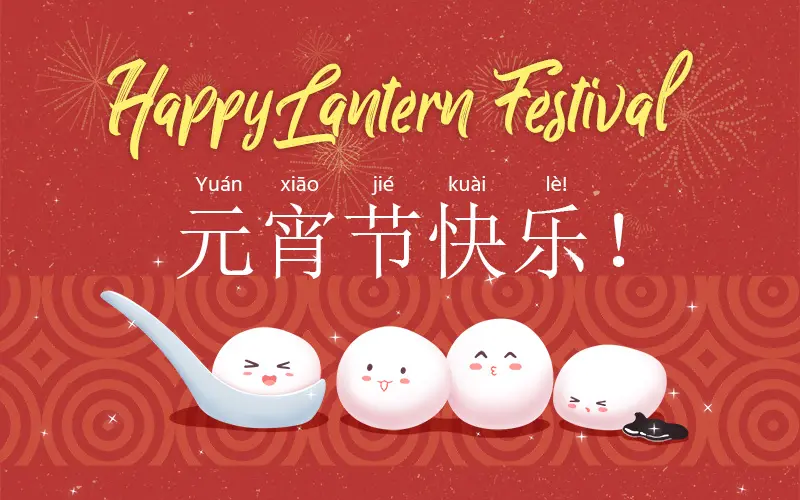
When is the Chinese Lantern Festival 2022?
Chinese Lantern Festival is on the 15th day of the first Chinese lunar month (always between February 4 and March 6). In 2022, the Chinese Lantern Festival will fall on Tuesday, February 15.
| Year | Chinese Lantern Festival Date |
|---|---|
| 2020 | February 8 |
| 2021 | February 26 |
| 2022 | February 15 |
| 2023 | February 5 |
| 2024 | February 24 |
The Significance of the Chinese Lantern Festival
Chinese New year, also called Spring Festival in China, marks the beginning of the Spring season. The Chinese Lantern Festival marks the final day of these celebrations. After the Lantern Festival, Chinese New Year taboos are no longer in effect, and all New Year decorations are taken down. Some people still wait till after the festival to return to work or study.
The lanterns symbolize people letting go of the past year and welcoming the new year with good fortune.
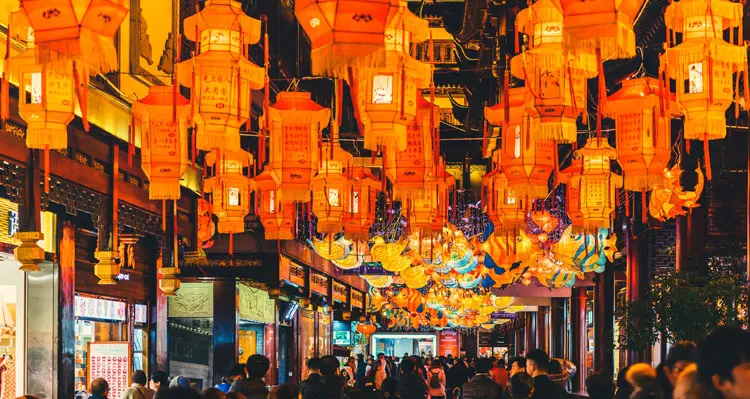 China's Lantern Festival
China's Lantern FestivalThe Origins and Stories of Chinese Lantern Festival
Chinese Lantern Festival can be traced back to 2,000 years ago. There are many origin stories about it. Here are two of the most popular ones:
Origin Story 1: A Buddhist Celebration
Ruling the beginning of the Eastern Han Dynasty (25–220), Emperor Hanmingdi was an advocate of Buddhism. He heard that some monks lit lanterns in their temples to show respect to Buddha on the fifteenth day of the first lunar month.
Therefore, he ordered that all the temples, households, and royal palaces should light lanterns on that evening. This Buddhist custom gradually became a grand festival among the people of China.
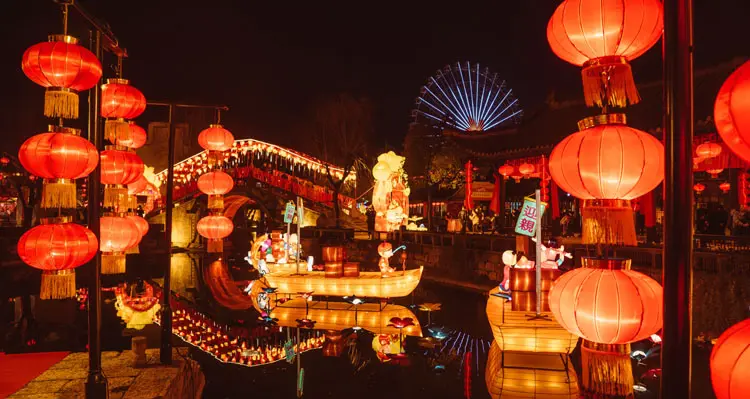
Origin Story 2: A Trick Played on the Jade Emperor
A legend has it that the Jade Emperor's favorite crane was killed by some villagers. So, he decided to destroy the village with fire on the fifteenth day of the lunar year. The Jade Emperor's daughter felt very sad about this and warned the villagers about what was going to happen.
Then, a wise man advised the villagers to hang red lanterns to give the Jade Emperor the impression that the village was already on fire. The emperor was fooled and the village survived. This tradition of hanging red lanterns on the fifteenth day of the lunar year has continued until the present time.
History of Chinese New Year
All good stories change bit over time, as each teller adds a little or changes something. A story that is over 3,500 years old has been told many times and it has taken on a life of its own.
The story of how the most important holiday in Chinese culture began is no different but many of the best bits have remained unchanged. The centuries-old legend of the origins of the Chinese New Year celebration always includes a story of a terrible mythical monster preying on villagers. The lion-like monster’s name was Nian (年), which is also the Chinese word for “year."
The stories often include a wise old man who counsels the villagers to ward off the evil Nian by making loud noises with drums and firecrackers and by hanging red paper cutouts and scrolls on their doors, because Nian is scared of the color red.So the villagers took the old man’s advice and Nian was conquered. On the anniversary of the date, the Chinese recognize the “passing of the Nian,” known in Chinese as guo nian (过年), which is synonymous with celebrating the new year.
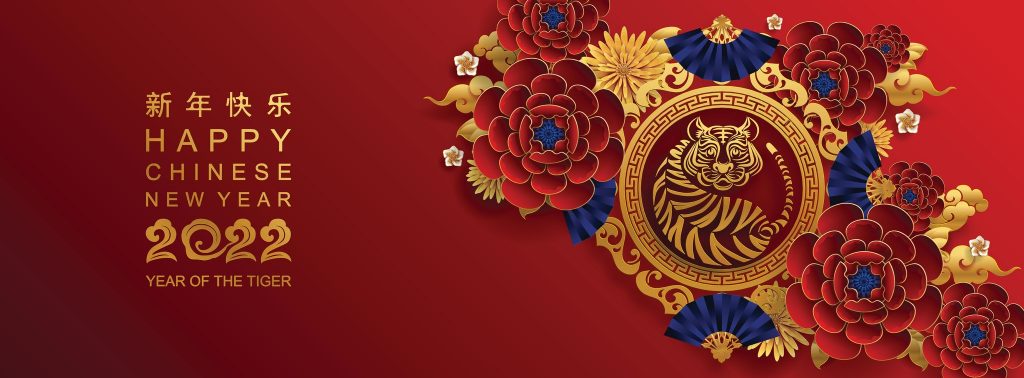 Lunar Calendar
Lunar Calendar
The date of Chinese New Year changes each year because it's based on the lunar calendar. While the western Gregorian calendar is based on the Earth’s orbit around the sun, the date of Chinese New Year is determined according to the moon’s orbit around the Earth. Chinese New Year falls on the second new moon after the winter solstice. Other Asian countries such as Korea, Japan, and Vietnam also celebrate the new year using the lunar calendar.
While Buddhism and Daoism have unique customs during the New Year, Chinese New Year is far older than both religions. As with many agrarian societies, Chinese New Year is rooted in a celebration of spring, like Easter or Passover.
Depending on where it's grown, the rice season in China lasts roughly from May to September (north China), April to October (Yangtze River Valley), or March to November (Southeast China). The New Year was likely the start of preparations for a new growing season.
Traditional Customs
On Chinese New Year, families travel long distances to meet and make merry. Known as the "Spring movement" or Chunyun (春运), a great migration takes place in China during this period as many travelers brave crowds to get to their hometowns.
Though the holiday is actually just a week long, traditionally it's celebrated as a 15-day holiday when firecrackers are lit, drums are heard on the streets, red lanterns glow at night, and red paper cutouts and calligraphy hang on doors. Children are also given red envelopes containing money. Many cities around the world hold New Year parades complete with dragon and lion dances. Celebrations conclude on the 15th day with the Lantern Festival.
Spring cleaning is a common theme during this time. Many Chinese families clean out their homes during the holiday. The New Year celebration could also have been a way to break up the boredom of the long winter months.
Food is an important component of the New Year. Traditional foods to eat include nian gao (sweet sticky rice cake) and savory dumplings.
Chinese New Year vs. Spring Festival
In China, New Year celebrations are synonymous with Spring Festival (春节 or chūn jié), which is typically a week-long celebration. The origins of this renaming from "Chinese New Year" to “Spring Festival” are fascinating and not widely known.
Chinese New Year, also known as the Lunar New Year or the Spring Festival, is the most important among the traditional Chinese festivals. The origin of the Chinese New Year festival can be traced back to about 3,500 years ago.
Chinese New Year has evolved over a long period of time and its customs have undergone a long development process.
Chinese Year Year - Over 3500 Years in the Making
 Chinese New Year's Origin: In the Shang Dynasty
Chinese New Year's Origin: In the Shang Dynasty
Chinese New Year has enjoyed a history of about 3,500 years. Its exact beginning is not recorded. Some people believe that Chinese New Year originated in the Shang Dynasty(1600–1046 BC), when people held sacrificial ceremonies in honor of gods and ancestors at the beginning or the end of each year.
Chinese Calendar "Year" Established: In the Zhou Dynasty
The term Nian ('year') first appeared in the Zhou Dynasty (1046–256 BC). It had become a custom to offer sacrifices to ancestors or gods, and to worship nature in order to bless harvests at the turn of the year.
Chinese New Year Date Was Fixed: In the Han Dynasty
The date of the festival, the first day of the first month in the Chinese lunar calendar, was fixed in the Han Dynasty (202 BC – 220 AD). Certain celebration activities became popular, such as burning bamboo to make a loud cracking sound.
In the Wei and Jin Dynasties
In the Wei and Jin dynasties (220–420), apart from worshiping gods and ancestors, people began to entertain themselves. The customs of a family getting together to clean their house, having a dinner, and staying up late on New Year’s Eve originated among common people.
More Chinese New Year Activities: From the Tang to Qing Dynasties
The prosperity of economies and cultures during the Tang, Song, and Qing dynasties accelerated the development of the Spring Festival. The customs during the festival became similar to those of modern times.
Setting off firecrackers, visiting relatives and friends, and eating dumplings became important parts of the celebration.
More entertaining activities arose, such as watching dragon and lion dances during the Temple Fair and enjoying lantern shows.
The function of the Spring Festival changed from a religious one to entertaining and social ones, more like that of today.
In Modern Times
In 1912, the government decided to abolish Chinese New Year and the lunar calendar, but adopted the Gregorian calendar instead and made January 1 the official start of the new year.
After 1949, Chinese New Year was renamed to the Spring Festival. It was listed as a nationwide public holiday.


